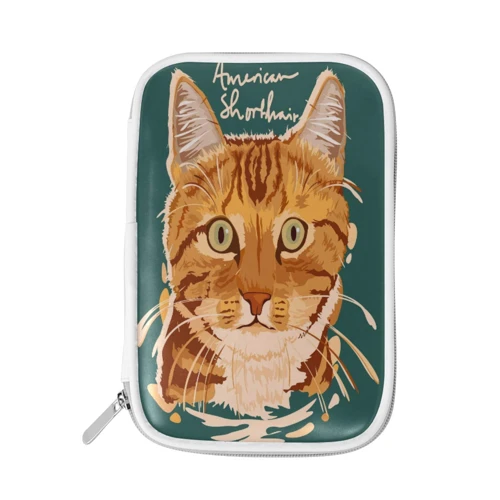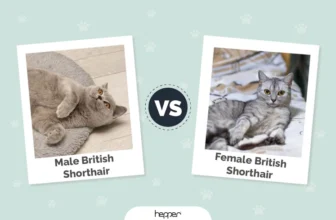You’ve just welcomed an adorable American Shorthair kitten into your home and are excited to start litter box training. As a new pet parent, you want to do everything right to ensure your furry friend is happy and comfortable at home. But with so much information out there, it can be overwhelming to know where to start. Fear not, we’ve got you covered! In this guide, we’ll walk you through the dos and don’ts of litter box training for your American Shorthair kitten, as well as troubleshooting tips for common issues. Let’s get started!
Litter Box Dos

Ensuring that your American Shorthair kitten is litter box trained is an important task for all cat owners. With patience, consistency, and the right approach, you can train your kitten to use the litter box without any issues. Here are some tips for successful litter box training that will lead to a happy and healthy relationship between you and your feline friend. If you want to avoid common mistakes during litter box training, check out our previous article on 10 Litter Box Mistakes to Avoid with Your American Shorthair.
1. Start Early
When it comes to litter box training your American Shorthair kitten, starting early is key. Ideally, you should introduce your kitten to the litter box as soon as they arrive in their new home. This gives them time to adjust to the new environment and understand where they should be doing their business. Early training sets the foundation for successful litter box habits later on in life.
To start, place the litter box in a quiet and accessible area of your home. Show your kitten where the litter box is by gently placing them in it and using a verbal cue like “go potty” or “use the litter box”. Repeat this process every few hours initially, especially after meal times or after your kitten wakes up from a nap.
It’s important to be patient during this process. Your kitten may not take to using the litter box right away, but with consistent encouragement, they will eventually get the hang of it. Be sure to praise and reward your kitten with a treat or verbal praise each time they successfully use the litter box.
Throughout the training process, keep an eye on your kitten’s behavior and body language. If they seem to be searching for a spot to go potty, guide them to the litter box and use the verbal cue. If they have an accident outside of the box, don’t punish them. Simply clean up the mess thoroughly and try to encourage them to use the litter box next time.
Early litter box training is crucial for preventing future litter box issues. By establishing good habits early on, your American Shorthair kitten will become a pro at using the litter box in no time. For more tips on litter box training, check out our article on how to train your American Shorthair to use the litter box.
2. Choose the Right Box and Litter
Choosing the right litter box and litter for your American Shorthair kitten is essential for successful litter box training. The wrong litter box or litter can discourage your kitten from using it, or worse, cause health problems. When selecting a litter box, consider the size of your kitten and how much space you have available. A box that is too small can be uncomfortable for your kitten, whereas a box that is too large can be challenging for them to climb in and out of. Also, ensure that the sides of the litter box are low enough for your kitten to easily enter and exit.
When it comes to choosing litter, there are a few factors to consider. Most kittens prefer a fine-grained, unscented litter. Strongly scented or perfumed litters can irritate sensitive feline noses and discourage them from using the box. Some popular litter options include clumping litter, clay litter, and natural litter. Each type has its own advantages and disadvantages, so it’s essential to choose an option that suits your kitten’s needs and your lifestyle.
Here’s a helpful table to summarize the different litter options:
| Litter Type | Advantages | Disadvantages |
|---|---|---|
| Clumping Litter | Easy to clean, forms clumps for easy removal of waste | Can create a lot of dust, may contain chemicals that can harm your kitten |
| Clay Litter | Inexpensive, absorbs odors well | Can be heavy and difficult to scoop, may contain silica which can be harmful if ingested |
| Natural Litter | Environmentally friendly, made from materials like recycled paper, corn or wheat | Can be expensive and not as effective at absorbing odors as other litter options |
Additionally, remember to clean the litter box frequently to keep it hygienic and free from unpleasant odors. Using a litter mat can also help reduce tracking and keep the box area clean. For more information on the best litter box options for American Shorthairs, check out this article.
3. Clean the Box Daily
Keeping the litter box clean is crucial for a successful litter box training with your American Shorthair kitten. If the box smells, your kitten might refuse to use it, resulting in accidents around the house. It is vital to clean the box daily.
Here are some tips for cleaning your kitten’s litter box:
| Task | Frequency |
|---|---|
| Remove solid waste | Once or twice a day |
| Stir the litter | Once a day or every other day |
| Completely change litter | Once a week |
Removing solid waste frequently will prevent odors and make the litter box more inviting for your kitten. You can use a scooper to remove solid waste and dispose of it in the trash. After scooping, you can stir the litter to prevent clumps from forming and ensure that the litter is evenly distributed.
Completely changing the litter once a week will keep the litter box clean and fresh. To do this, empty the litter box, wash it with warm water and a mild detergent, and fill it with fresh litter. Remember to use a litter that your kitten likes, as sudden changes might confuse or upset them.
If you notice that your kitten is avoiding the litter box despite your daily cleaning routine, there might be an underlying issue that needs attention. Check for possible medical or environmental reasons for your kitten’s behavior. For more information on troubleshooting litter box issues, check out our litter box troubleshooting guide.
By keeping your kitten’s litter box clean, you are ensuring a healthy and hygienic environment for both your kitten and your household. For more information on how to clean your American Shorthair’s litter box, check out our dedicated article on cleaning the litter box with American Shorthair.
4. Place the Box in a Private Location
Choosing the right location for your American Shorthair kitten’s litter box is crucial for successful litter box training. A private location is ideal as it will provide your kitten with a sense of security and privacy, making them more willing to use the litter box. Additionally, placing the litter box in a private location will also prevent your kitten from feeling vulnerable while using it, which could lead to them avoiding the litter box altogether and preferring other areas of your home instead.
So where should you place your kitten’s litter box?
Consider placing the litter box in a quiet and low-traffic area of your home, such as a spare bathroom or a corner of a room. Avoid placing the litter box in areas with high foot traffic or where your kitten may feel exposed, such as near a loud appliance or in an open space. Also, be sure to place the box away from your kitten’s food and water dishes, as cats prefer to have their eating and elimination areas separate.
What if you live in a small apartment or don’t have a private space to spare?
In this case, consider using a privacy screen to cordon off a section of your living space for the litter box. Alternatively, you can use furniture such as bookshelves or cabinets to create a private nook for the litter box. Just make sure that your kitten can easily access and exit the litter box without any obstacles.
Remember, cats are creatures of habit, and once they get used to a particular location for their litter box, they may become reluctant to use it if it is moved. So, choose your kitten’s litter box location wisely and stick to it.
To learn more about litter box training for your American Shorthair kitten, read our article on litter box training and behavior for this breed.
5. Use Positive Reinforcement
When it comes to litter box training your American Shorthair kitten, positive reinforcement can be incredibly effective in encouraging good behavior. Positive reinforcement involves rewarding your kitten for using the litter box correctly, rather than punishing them for accidents. This helps to create a positive association with the litter box, making it more likely that your kitten will continue to use it in the future.
Here are some effective ways to use positive reinforcement in your litter box training:
| Method | Description |
|---|---|
| Treats | Give your kitten a small treat every time they use the litter box correctly. This will help to reinforce the desired behavior and encourage them to continue using the litter box. |
| Verbal praise | When your kitten uses the litter box correctly, offer them verbal praise, such as saying “good job” or “well done”. This can be just as effective as treats in reinforcing positive behavior. |
| Playtime | After your kitten uses the litter box correctly, offer them some playtime with their favorite toy. This can help to create a positive association with the litter box and encourage them to continue using it. |
Remember, it’s important to be consistent and patient when using positive reinforcement. Your kitten may not get it right the first time, but with repetition and consistent positive reinforcement, they will eventually learn to use the litter box correctly. If you find that your kitten is still having trouble using the litter box, there may be other underlying issues that need to be addressed.
Litter Box Don’ts

As important as it is to know what to do when litter box training your American Shorthair Kitten, it’s equally important to know what not to do. To avoid potential setbacks and ensure a smooth and successful litter box training process, keep these “don’ts” in mind. By avoiding these common mistakes, you can establish good litter box habits for your kitten from the start. Let’s take a closer look at what not to do when litter box training your American Shorthair Kitten.
1. Punish Your Kitten for Accidents
When litter box accidents happen, it can be frustrating, but it’s important to remember that punishing your American Shorthair kitten is not a solution. Here’s why:
1. It creates fear and anxiety: If you punish your kitten for litter box accidents, they may become scared of you or the litter box, causing more stress and anxiety. They may even start hiding their accidents from you, making it harder to address the root of the problem.
2. Your kitten won’t understand: Cats don’t have the same understanding as humans, so punishing them for accidents won’t teach them anything. They won’t understand why they are being punished and will only feel confused.
3. Punishment can make the problem worse: Punishing your kitten can actually make the litter box problem worse, as it can cause stress-induced behaviors like peeing or pooping outside of the box.
Instead of punishment, try positive reinforcement. When your kitten uses the litter box, give them treats or praise to encourage good behavior. If accidents do happen, clean them up gently and without fuss. By staying patient and positive, you can help your American Shorthair kitten feel comfortable and confident using their litter box.
2. Change the Litter Abruptly
Changing the litter box is an essential part of keeping your American Shorthair kitten healthy and happy, but it’s important to do it gradually. Abruptly changing the type of litter you use can upset your kitten’s sensitive nose and cause them to avoid using the box altogether. To avoid any issues, make sure to transition to a new type of litter slowly over a period of several days.
Table:
| Do | Don’t |
|---|---|
| Introduce the new litter by mixing it in with the current litter. Start with a small amount of the new litter and gradually increase the amount each day. | Empty the litter box completely and refill it with a different type of litter all at once. |
| Observe your kitten’s behavior to ensure they are comfortable with the new litter. If they seem hesitant to use the box, consider slowing down the transition process. | Assume that your kitten will adapt to a new type of litter right away. |
| Clean the litter box regularly during the transition to prevent any unpleasant odors or contamination. | Ignore any signs that your kitten is having trouble adjusting to the new litter. |
Remember, litter box training requires patience and consistency. By following these guidelines and transitioning to new litter slowly and gradually, you can ensure that your American Shorthair kitten remains comfortable and happy while using their litter box.
3. Use Strong Chemical Cleaners
One of the biggest mistakes cat owners make when litter box training their American Shorthair kitten is using strong chemical cleaners to clean the litter box. While it may seem like a good idea to use a powerful cleaner to eliminate any odors, the truth is that cats have a strong sense of smell and may be deterred from using the litter box if it is too heavily scented.
Here are some reasons why you should avoid using strong chemical cleaners:
- It can irritate your kitten’s nose and lungs: Strong cleaning chemicals can leave a lingering scent that can irritate your kitten’s sensitive nose and lungs, causing respiratory problems.
- It can affect your kitten’s litter box habits: Using strong chemical cleaners to clean your kitten’s litter box can make your kitten associate the box with a chemical scent rather than the scent of their own urine and feces, leading them to avoid using it altogether.
- It can be harmful to your kitten’s health: Many cleaning products contain toxic chemicals that can be harmful to your kitten’s health. They may also leave behind traces of chemicals that your kitten can ingest while grooming themselves.
- It can damage the litter box: Strong chemicals can cause damage to plastic litter boxes, making them more difficult to clean and more likely to harbor bacteria and smells in the future.
So, what should you use instead?
The best way to clean your American Shorthair kitten’s litter box is to use a mild soap and warm water. This will remove any residue without leaving behind a strong scent that can irritate your kitten’s nose and lungs. You can also use a small amount of white vinegar to help neutralize odors.
It’s important to clean the litter box daily to prevent odors and bacteria from building up. Simply scoop out any waste and soiled litter, and replace it with fresh litter as needed. By adopting good litter box cleaning habits and avoiding the use of strong chemical cleaners, you can ensure that your American Shorthair kitten is happy, healthy, and confident in their litter box usage.
4. Move the Box Too Often
Moving the litter box around too often can cause confusion for your American Shorthair kitten, which can lead to litter box issues. It’s important to find the right location for the box in the beginning and stick to it. Here are some reasons why you should avoid moving the box too often:
- Stress: Moving the litter box around can cause your kitten to become stressed and anxious. This can lead to them avoiding the box altogether and going to the bathroom elsewhere in the house.
- Confusion: Consistency is key when it comes to litter box training. Moving the box too often can confuse your kitten and make them unsure of where to go. This can lead to accidents outside of the box.
- Decreased Use: If your kitten becomes too confused or stressed by the box being moved, they may start avoiding it altogether. This can lead to decreased use of the litter box and an increase in accidents outside of the box.
To avoid these issues, it’s important to choose the right location for the litter box in the beginning. Find a quiet, private area that your kitten can access easily. If you need to move the box, do so gradually over a period of days or weeks so that your kitten can adjust to the new location. By avoiding frequent moves of the litter box, you can help ensure that your American Shorthair kitten has a positive litter box experience.
5. Neglect to Add More Litter
Forgetting to add more litter to the litter box can lead to a number of issues for both you and your American Shorthair kitten. Without enough litter, your kitten may struggle to find a suitable spot to do their business, resulting in accidents around the house. Additionally, a lack of litter can also lead to unpleasant odors, which nobody wants in their home. Here are some key reasons why you should never neglect to add more litter to the litter box:
1. It can lead to more messes: As your kitten uses the litter box, they will naturally kick up and scatter some of the litter around. If there isn’t enough litter to cover these messes, they can quickly build up and create a larger mess for you to clean up later.
2. It can be uncomfortable for your kitten: Without enough litter, your kitten may struggle to dig and bury their waste properly, which can be uncomfortable and unpleasant for them. This may lead to your kitten avoiding the litter box altogether and creating more messes in other parts of the house.
3. It can lead to bad odors: Litter is designed to absorb unpleasant smells and keep your home smelling fresh. If there isn’t enough litter to do this job, odors can quickly build up and become overwhelming. This can make your home an unpleasant place to be for both you and your kitten.
4. It can impact the lifespan of the litter box: Neglecting to add more litter can also impact the lifespan of your litter box. When there isn’t enough litter, your kitten’s waste can sit on the bottom of the box and create difficult-to-clean stains and odors. Over time, this can lead to the breakdown of the materials that make up the litter box and the need for more frequent replacements.
To ensure that your kitten has a clean and comfortable place to do their business, it’s important to make sure that you add more litter to the litter box regularly. Aim to add an extra layer of litter every few days, or as needed, to keep the box clean and comfortable for your kitten.
Troubleshooting Litter Box Issues
When it comes to litter box training, things don’t always go as smoothly as planned. Sometimes, your American Shorthair kitten may experience issues with using the litter box. Don’t worry, though—there are solutions to these problems. In this section, we’ll explore some of the most common litter box issues and how to troubleshoot them. With a bit of patience and problem-solving, you and your kitten can conquer any litter box challenge.
1. Address Medical Issues First
It is important to address any potential medical issues before assuming that your American Shorthair Kitten is simply being disobedient. Some medical issues that could be causing litter box problems include urinary tract infections, bladder stones, and digestive issues. These conditions can make it difficult for your kitten to control their bathroom habits, causing accidents outside of the litter box.
To properly address any potential medical issues, it is important to schedule an appointment with your veterinarian. They will be able to properly diagnose and treat any underlying medical conditions affecting your kitten’s litter box habits. In the meantime, here are some common signs to look out for that may indicate a medical issue:
| Signs of Medical Issues | Possible Medical Condition |
|---|---|
| Frequent urination outside of the litter box | Urinary tract infection or bladder stones |
| Pain or discomfort during urination | Urinary tract infection or bladder stones |
| Bloody urine | Urinary tract infection or bladder stones |
| Diarrhea or constipation | Digestive issues |
| Loss of appetite or weight | Various illnesses or conditions |
If any of these signs are present, it is important to seek veterinary attention as soon as possible. Ignoring medical issues can lead to more serious health problems down the line.
It is important to always consider the potential of underlying medical issues when dealing with litter box problems in American Shorthair Kittens. Your veterinarian should always be your first point of contact in these situations.
2. Address Environmental Issues Second
Once you’ve ruled out any medical issues that might be impacting your American Shorthair kitten’s litter box habits, it’s time to address environmental factors that could be causing problems. Here are some steps you can take to address environmental issues:
- Check the Location of the Litter Box: Make sure the litter box is in a private, quiet area away from high-traffic areas. Cats prefer a sense of privacy when using the litter box, so a noisy or busy location could be deterring your kitten from using it.
- Clean the Litter Box: Your kitten might avoid using the litter box if it’s dirty or has an unpleasant smell. Be sure to clean it regularly and consider adding a new layer of litter every few days.
- Check the Type of Litter: Cats can be picky about their litter, so consider switching to a different type if your kitten is consistently avoiding the current one. Some cats prefer clumping, scented, or unscented litter, so try different options until you find the one that works best.
- Consider the Size of the Litter Box: A litter box that’s too small can be uncomfortable for your kitten and deter them from using it. Make sure the litter box is large enough for your American Shorthair kitten to move around comfortably.
- Keep the Litter Box Accessible: If your kitten has to climb over obstacles or navigate narrow spaces to reach the litter box, they might avoid it altogether. Keep the litter box easily accessible so your kitten can use it without difficulty.
By addressing any potential environmental issues, you can help your American Shorthair kitten feel more comfortable using the litter box and reduce the likelihood of accidents happening outside of it.
3. Seek Professional Help if Needed
If your American Shorthair kitten is still having issues with litter box training despite trying all of the previously mentioned options, seeking professional help may be the solution. There are several instances where professional intervention may be necessary, such as if your kitten is experiencing medical issues, if it has developed a fear or aversion to the litter box, or if it is experiencing behavior issues.
Litter Box Training Help
A professional animal behaviorist can assess any underlying causes for the litter box issue and recommend specific training techniques. They may also advise on how to help your kitten overcome any fear or aversion to using the litter box.
Medical Issues
If your kitten is repeatedly having accidents outside of the litter box despite proper training, it may have an underlying medical issue. A veterinarian can diagnose and treat any potential medical problems that may be causing the behavior.
Environmental Factors
Your kitten may be stressed or anxious due to environmental factors in your home, such as changes in routine or the introduction of new pets. A professional can assist in identifying any stressors and provide advice on how to mitigate them.
| Professional Help | What to Expect |
|---|---|
| Animal Behaviorist | Assessment of training needs and techniques to overcome any aversions or fears related to litter box, as well as recommendations for ongoing training or modifications to the litter box or surrounding environment. |
| Veterinarian | Diagnosis and treatment of any medical issues that could be causing inappropriate litter box behavior. |
Ultimately, seeking professional help should be viewed as a last resort. With patience and persistence, most American Shorthair kittens can successfully be litter box trained using the tips outlined in this article. However, if all efforts fail and your kitten continues to have litter box issues, do not hesitate to seek the help of a trained professional to ensure your kitten’s health and happiness.
Conclusion
In conclusion, litter box training your American Shorthair kitten can be an easy and stress-free process if you follow the dos and avoid the don’ts. Remember to start early, choose the right box and litter, clean the box daily, place it in a private location, and use positive reinforcement. On the other hand, avoid punishing your kitten for accidents, changing the litter abruptly, using strong chemical cleaners, moving the box too often, and neglecting to add more litter.
If you do encounter any issues, remember to address any potential medical issues first and then address any environmental issues. If the problem persists, don’t hesitate to seek help from a professional.
By taking the time to properly litter box train your kitten, you can help ensure that they have a happy and healthy life in your home. So, make sure to follow these tips and be patient with your kitten as they adjust to this new routine. With a little perseverance and consistency, your kitten will successfully learn how to use their litter box and you can enjoy a clean and odor-free home.
Frequently Asked Questions
1. Can kittens be litter trained?
Yes, kittens can be litter trained at a young age.
2. Do American Shorthair kittens need a special litter box?
No, American Shorthair kittens do not require a special litter box. Any standard litter box will work.
3. How often should I clean the litter box?
The litter box should be cleaned daily to prevent odors and keep your kitten from having accidents outside the box.
4. Can I punish my kitten for not using the litter box?
No, punishment is not an effective training method. Positive reinforcement is the best way to train your kitten to use the litter box.
5. What kind of litter is best for American Shorthair kittens?
Use unscented clumping litter as it is safer for your kitten’s respiratory system. Avoid using clay or scented litters.
6. Can I move the litter box to different locations in my home?
It’s not recommended to move the litter box too often, as this can confuse your kitten and cause accidents outside of the box.
7. My kitten is not using the litter box. What should I do?
First, check with a veterinarian to rule out any medical issues. Then, check the placement of the litter box, type of litter, and cleaning frequency to ensure it’s not an environmental issue.
8. How long does it usually take for a kitten to be litter trained?
It can take anywhere from a few days to a few weeks for a kitten to be fully litter trained.
9. Can I use chemical cleaners to clean the litter box?
No, it’s not recommended to use strong chemical cleaners in or around the litter box as this can be harmful to your kitten.
10. Should I use a covered litter box for my kitten?
No, it’s best to avoid covered litter boxes as they can be cramped and restrictive for your kitten. An open litter box provides more space and accessibility.







